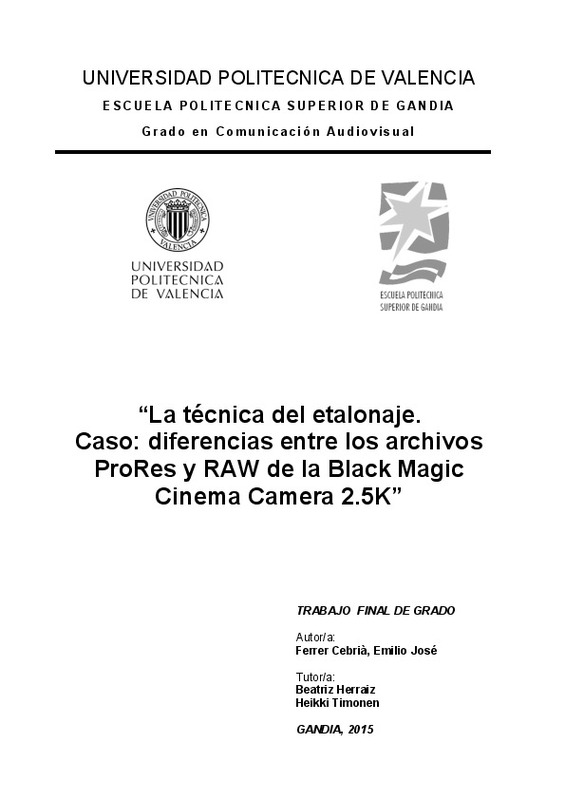JavaScript is disabled for your browser. Some features of this site may not work without it.
Buscar en RiuNet
Listar
Mi cuenta
Estadísticas
Ayuda RiuNet
Admin. UPV
La técnica del etalonaje. Caso: diferencias entre los archivos ProRes y RAW de la Black Magic Cinema Camera 2.5K
Mostrar el registro sencillo del ítem
Ficheros en el ítem
| dc.contributor.advisor | Herráiz Zornoza, Beatriz
|
es_ES |
| dc.contributor.advisor | Timonen, Heikki
|
es_ES |
| dc.contributor.author | Ferrer Cebrià, Emilio José
|
es_ES |
| dc.date.accessioned | 2015-10-21T08:28:44Z | |
| dc.date.available | 2015-10-21T08:28:44Z | |
| dc.date.created | 2015-07-15 | |
| dc.date.issued | 2015-10-21 | es_ES |
| dc.identifier.uri | http://hdl.handle.net/10251/56291 | |
| dc.description.abstract | The idea of this thesis arises from my interest in new technologies applied to film. Specifically for my personal interest in the evolution of colour grading with the arrival of digital cinema. The main objective of this work is to observe the behaviour offered by RAW and Apple Prores recording formats of the Black Magic Cinema Camera during the colour grading. Thesis define the concept of colour grading and the process from preproduction of an audiovisual project to the completion during postproduction. Some key concepts relevant to colour and digital image will also be defined for a perfect understanding for the practical part of the project. Later I will study through a series of analyses the response of RAW and Apple ProRes files when they are subjected to the colour grading processes. During this stage I will obtain a series of results with which I can make a number of conclusions. I can define the response during grading colour for each of the two signals. The results obtained after having done all this process have been totally unexpected. We might have thought that the ProRes files, under strong signal compression, would provide a worse outcome compared to RAW files. However, they have shown to withstand a professional quality comparable to the result obtained by RAW signals. If we think with the technical limitations that arise depending on weather we are using one or the other format, we must ask us if we should use RAW files Black magic cinema camera regarding Apple ProRes files. | es_ES |
| dc.format.extent | 31 | es_ES |
| dc.language | Inglés | es_ES |
| dc.publisher | Universitat Politècnica de València | es_ES |
| dc.rights | Reserva de todos los derechos | es_ES |
| dc.subject | Fotografía digital | es_ES |
| dc.subject | Color grading | es_ES |
| dc.subject | Davinci resolve | es_ES |
| dc.subject | Color correction | es_ES |
| dc.subject | Blackmagic | es_ES |
| dc.subject | Etalonaje | es_ES |
| dc.subject | Correccion de color | es_ES |
| dc.subject | RAW | es_ES |
| dc.subject | Apple ProRes | es_ES |
| dc.subject.classification | COMUNICACION AUDIOVISUAL Y PUBLICIDAD | es_ES |
| dc.subject.other | Grado en Comunicación Audiovisual-Grau en Comunicació Audiovisual | es_ES |
| dc.title | La técnica del etalonaje. Caso: diferencias entre los archivos ProRes y RAW de la Black Magic Cinema Camera 2.5K | es_ES |
| dc.type | Proyecto/Trabajo fin de carrera/grado | es_ES |
| dc.rights.accessRights | Abierto | es_ES |
| dc.contributor.affiliation | Universitat Politècnica de València. Escuela Politécnica Superior de Gandia - Escola Politècnica Superior de Gandia | es_ES |
| dc.contributor.affiliation | Universitat Politècnica de València. Departamento de Comunicación Audiovisual, Documentación e Historia del Arte - Departament de Comunicació Audiovisual, Documentació i Història de l'Art | es_ES |
| dc.description.bibliographicCitation | Ferrer Cebrià, EJ. (2015). La técnica del etalonaje. Caso: diferencias entre los archivos ProRes y RAW de la Black Magic Cinema Camera 2.5K. Universitat Politècnica de València. http://hdl.handle.net/10251/56291 | es_ES |
| dc.description.accrualMethod | TFGM | es_ES |
| dc.relation.pasarela | TFGM\27259 | es_ES |
Este ítem aparece en la(s) siguiente(s) colección(ones)
-
EPSG - Trabajos académicos [5004]
Escuela Politécnica Superior de Gandia






